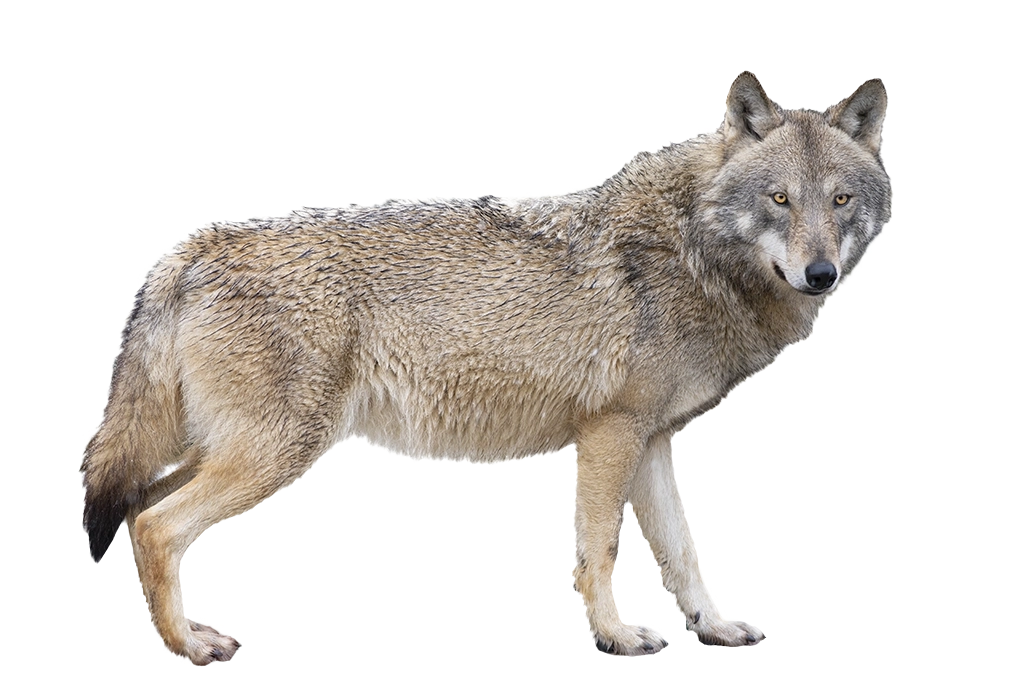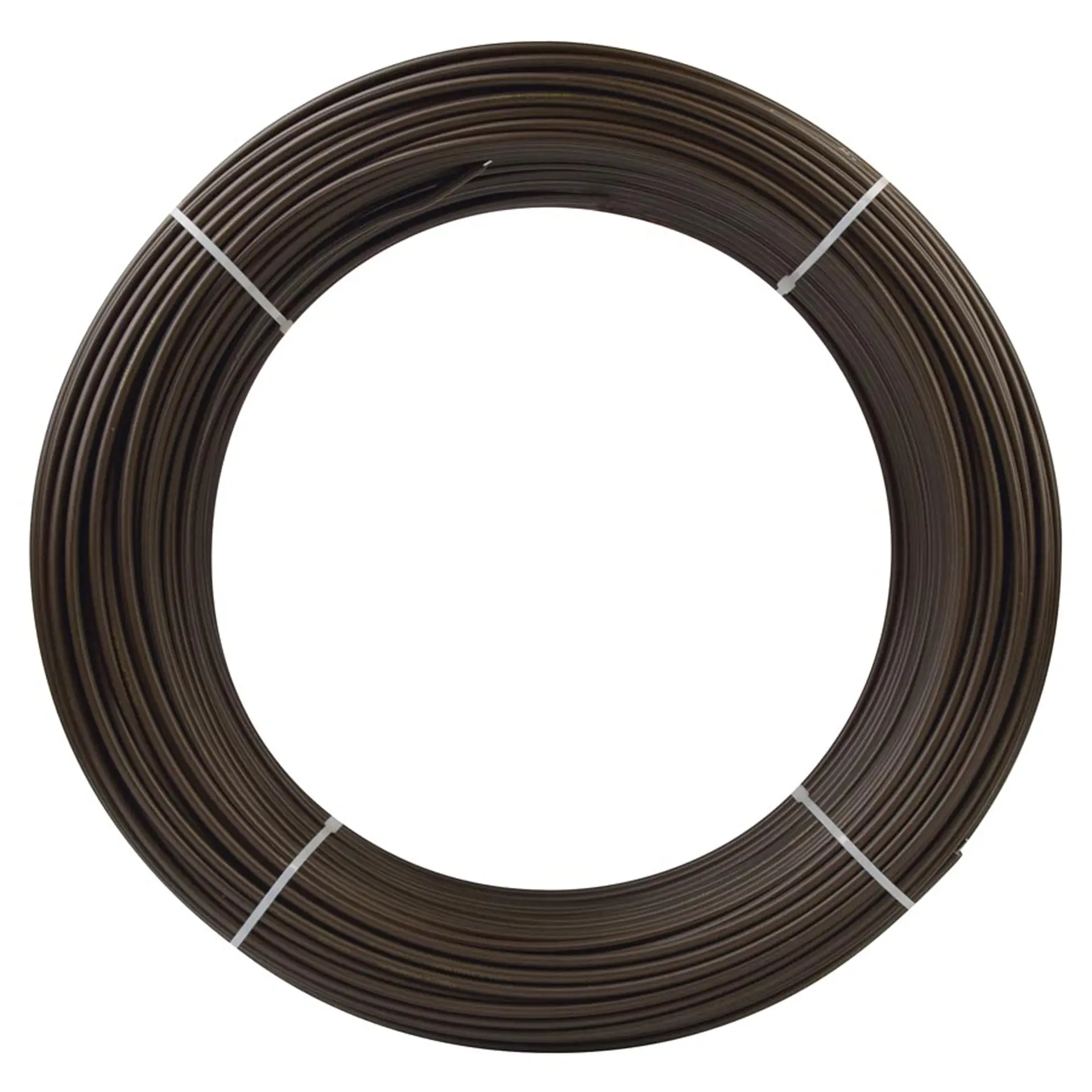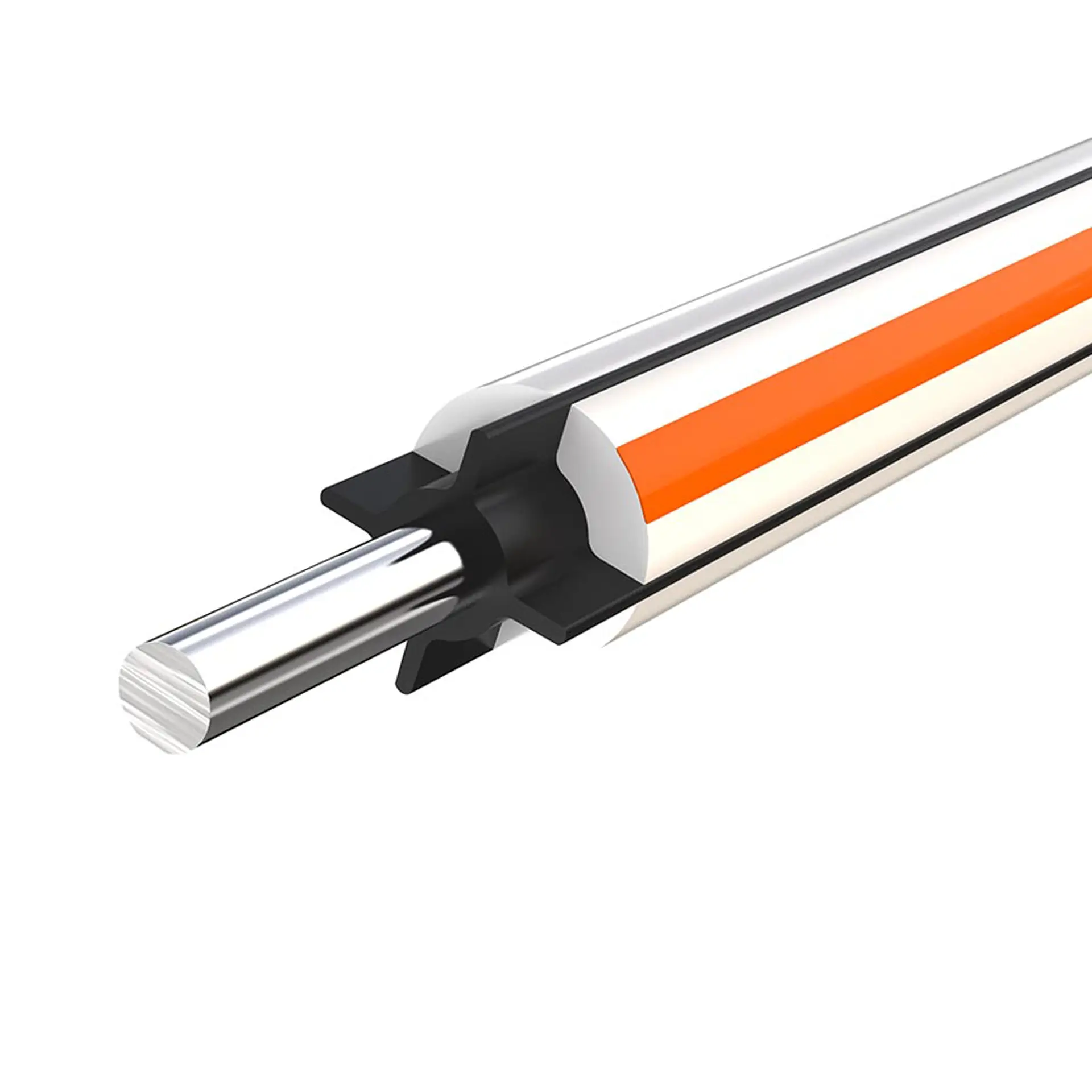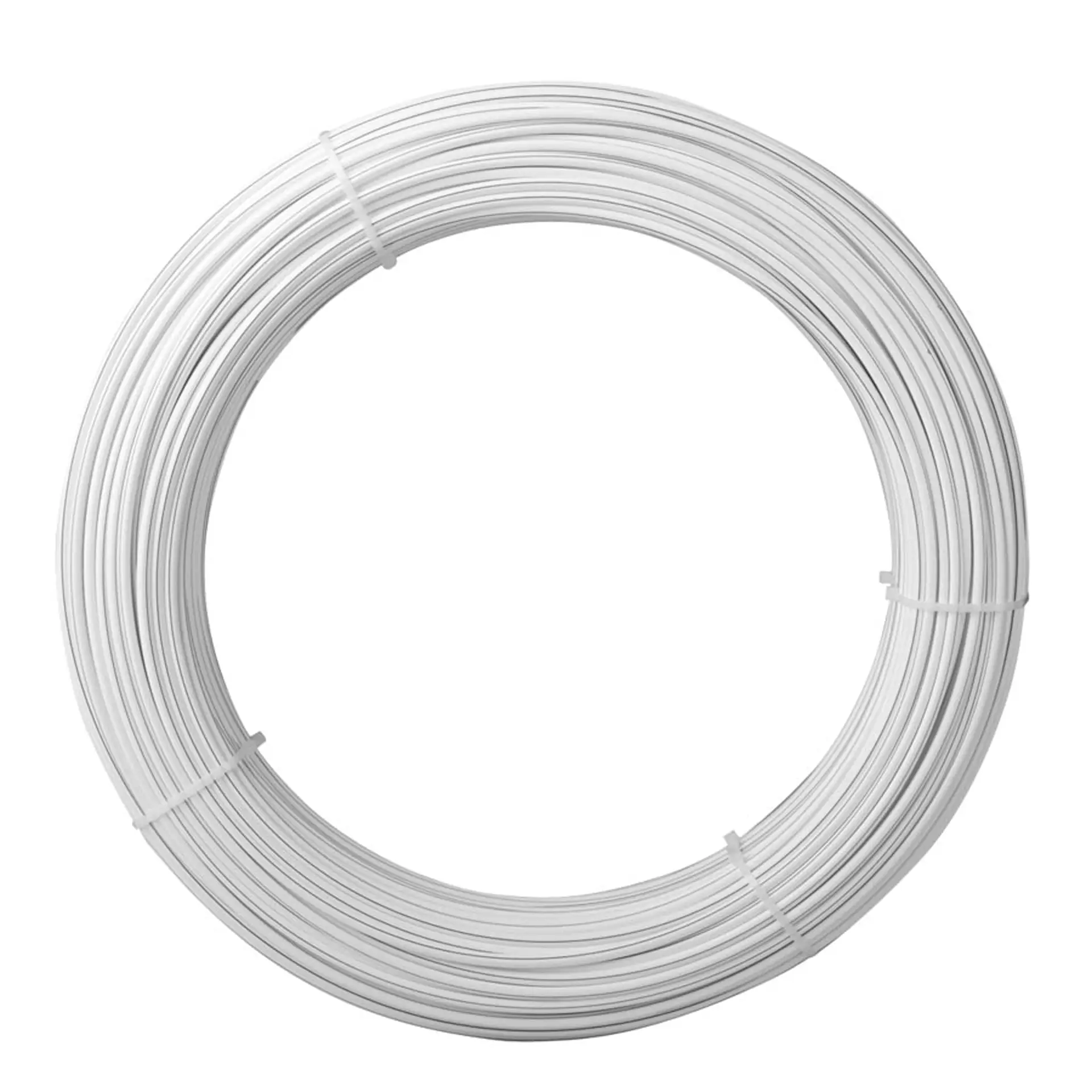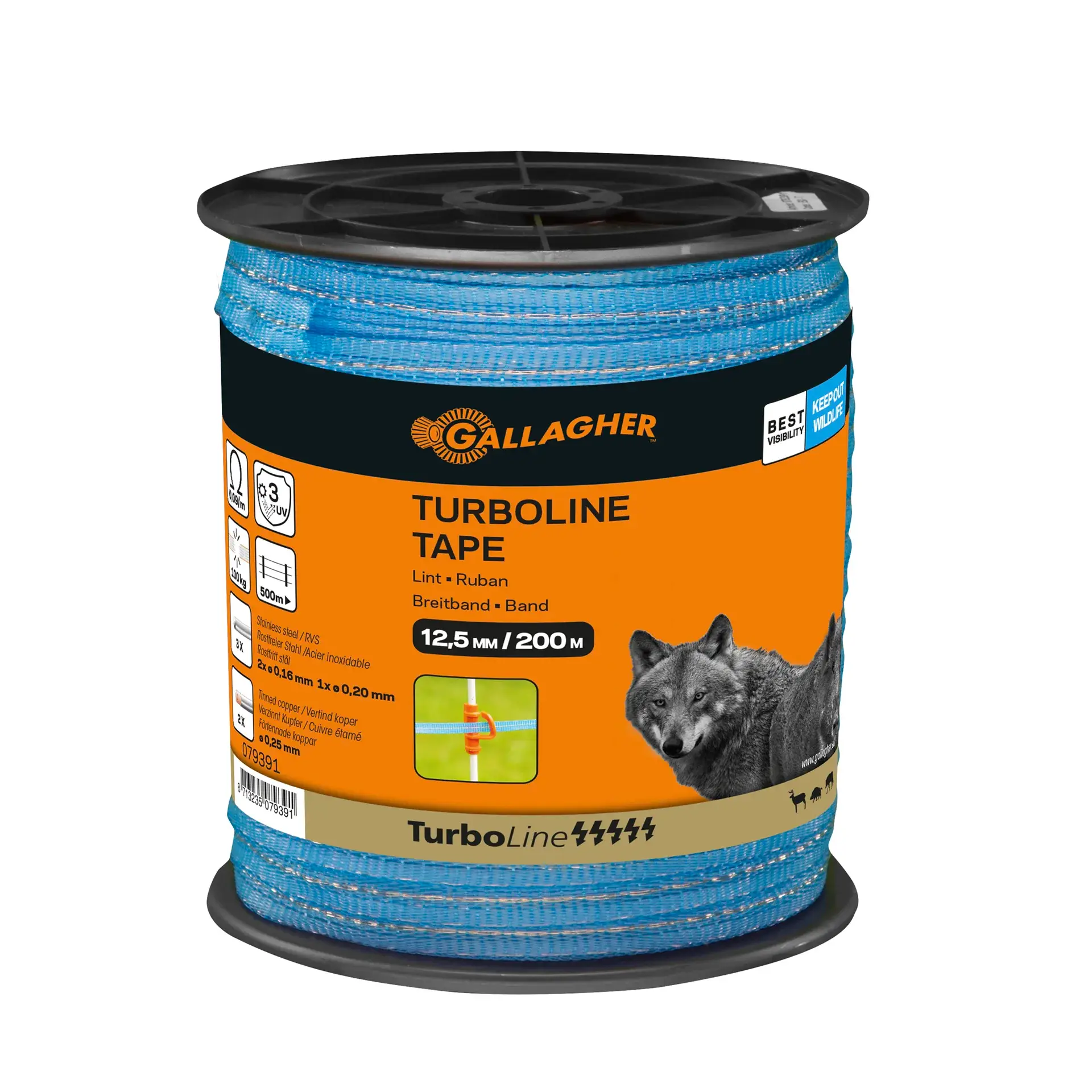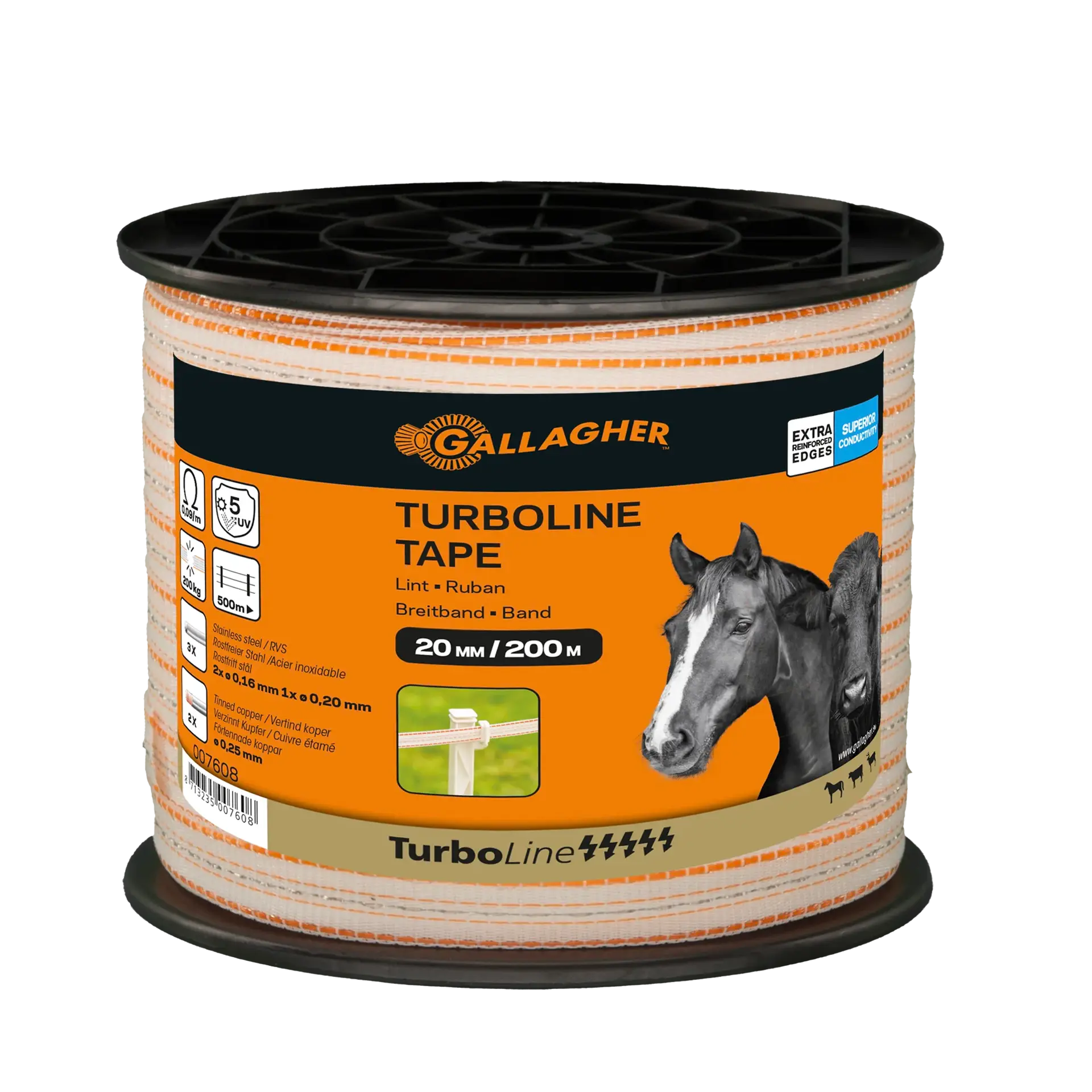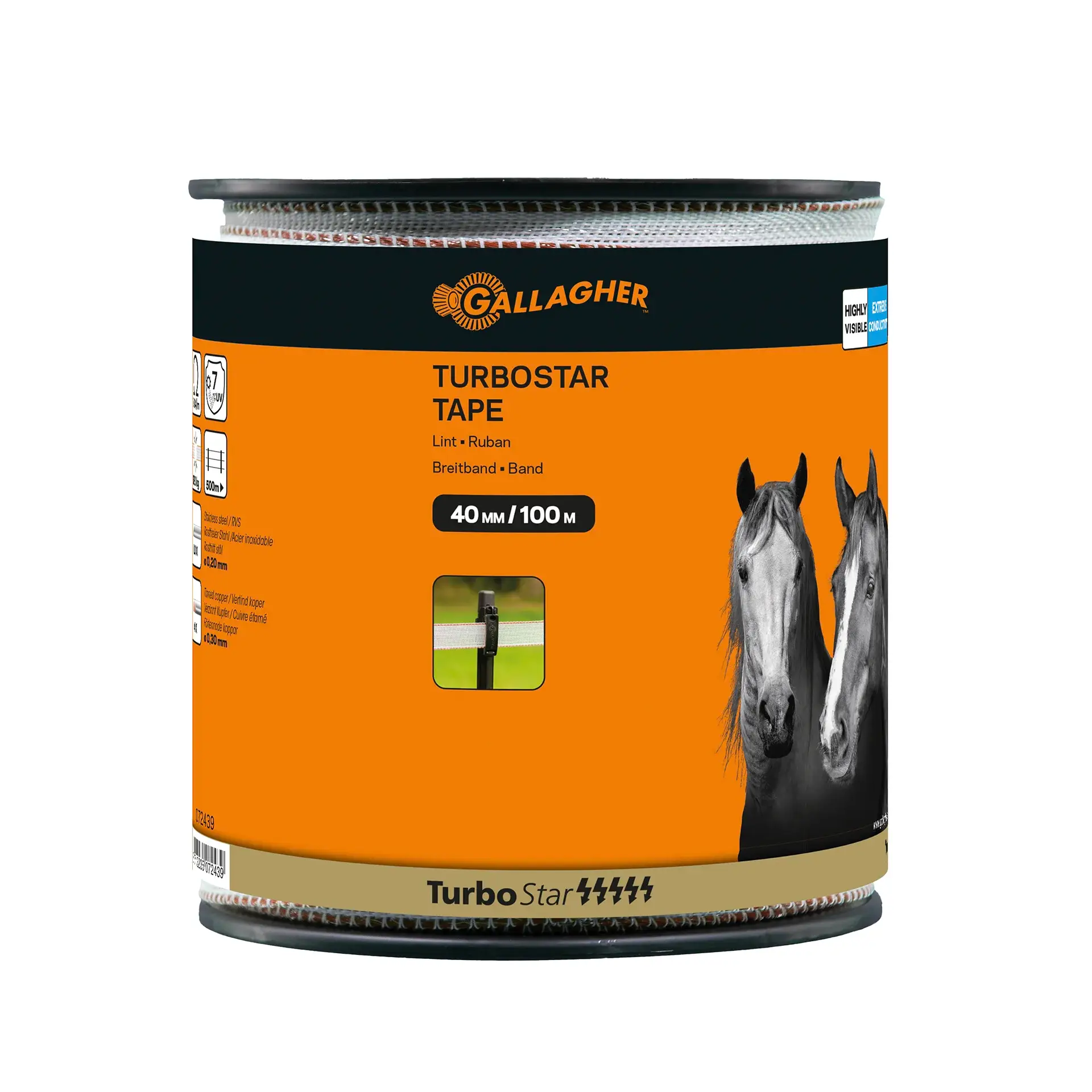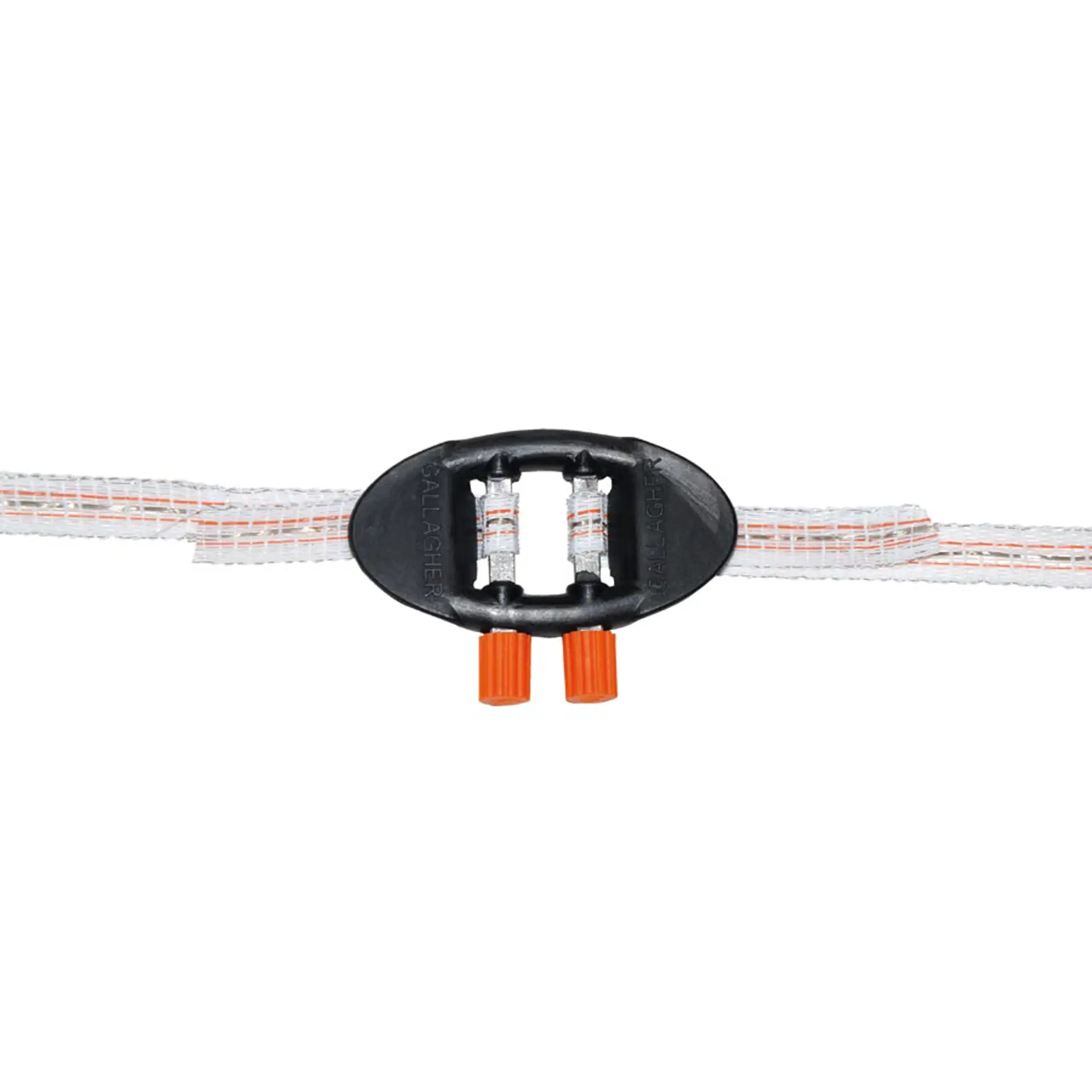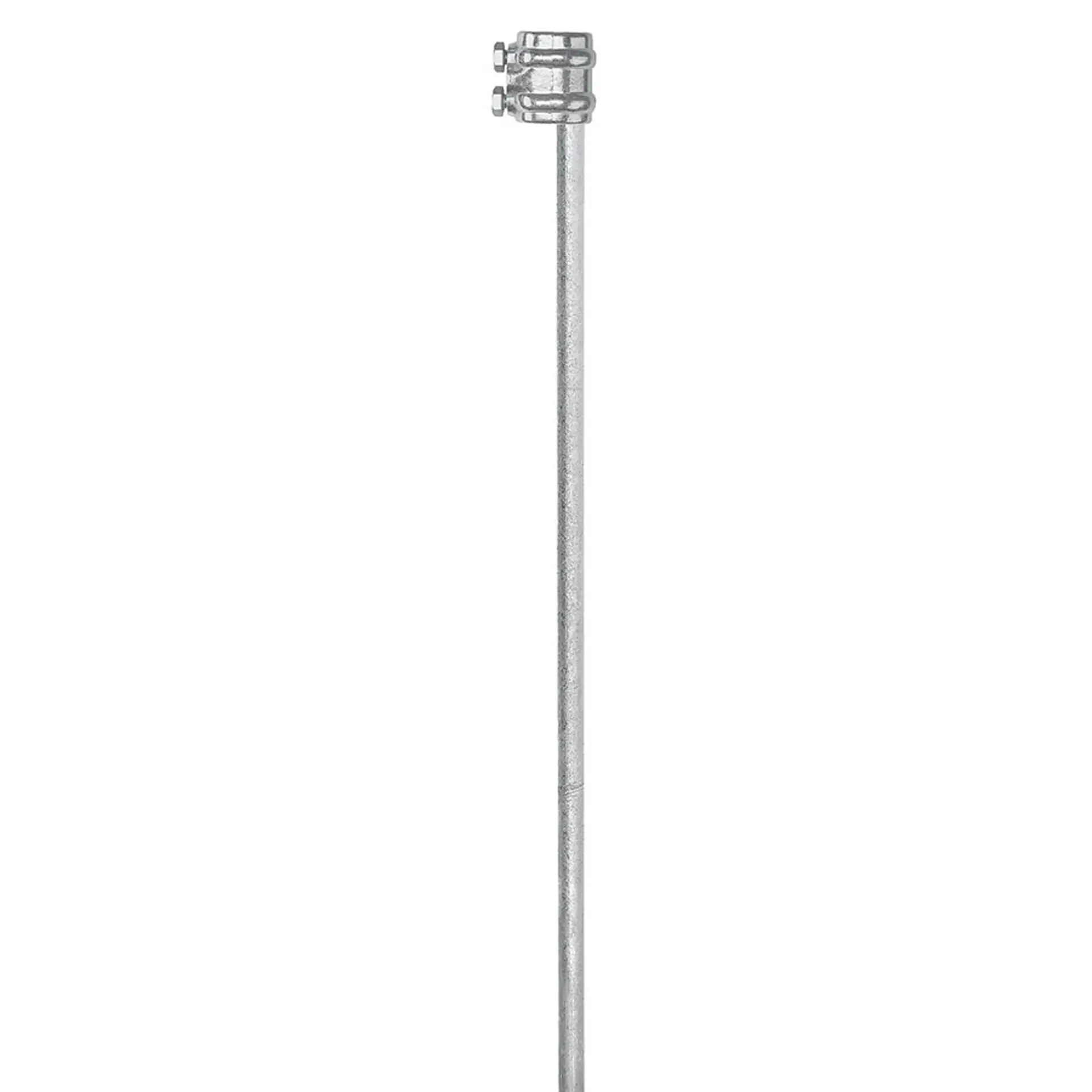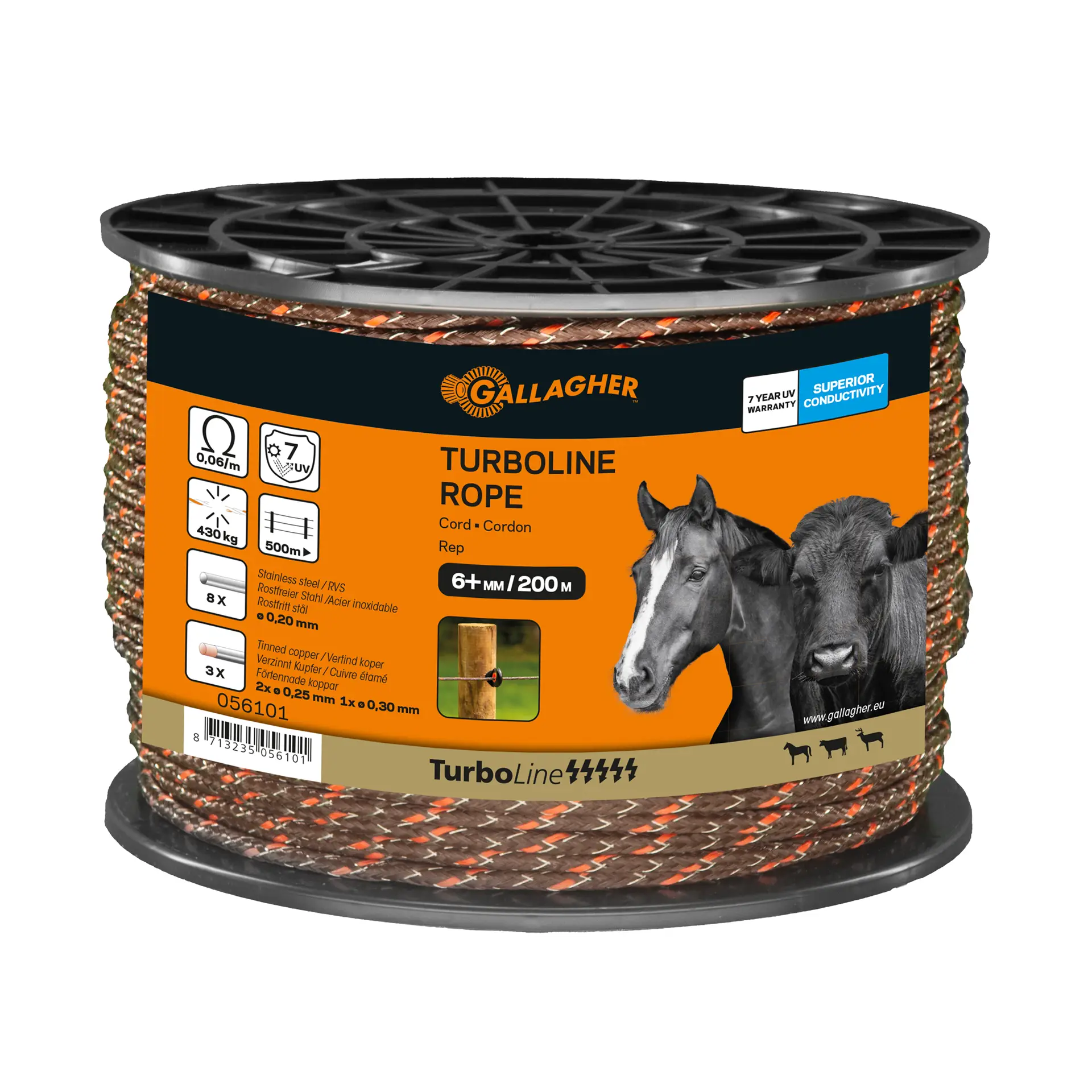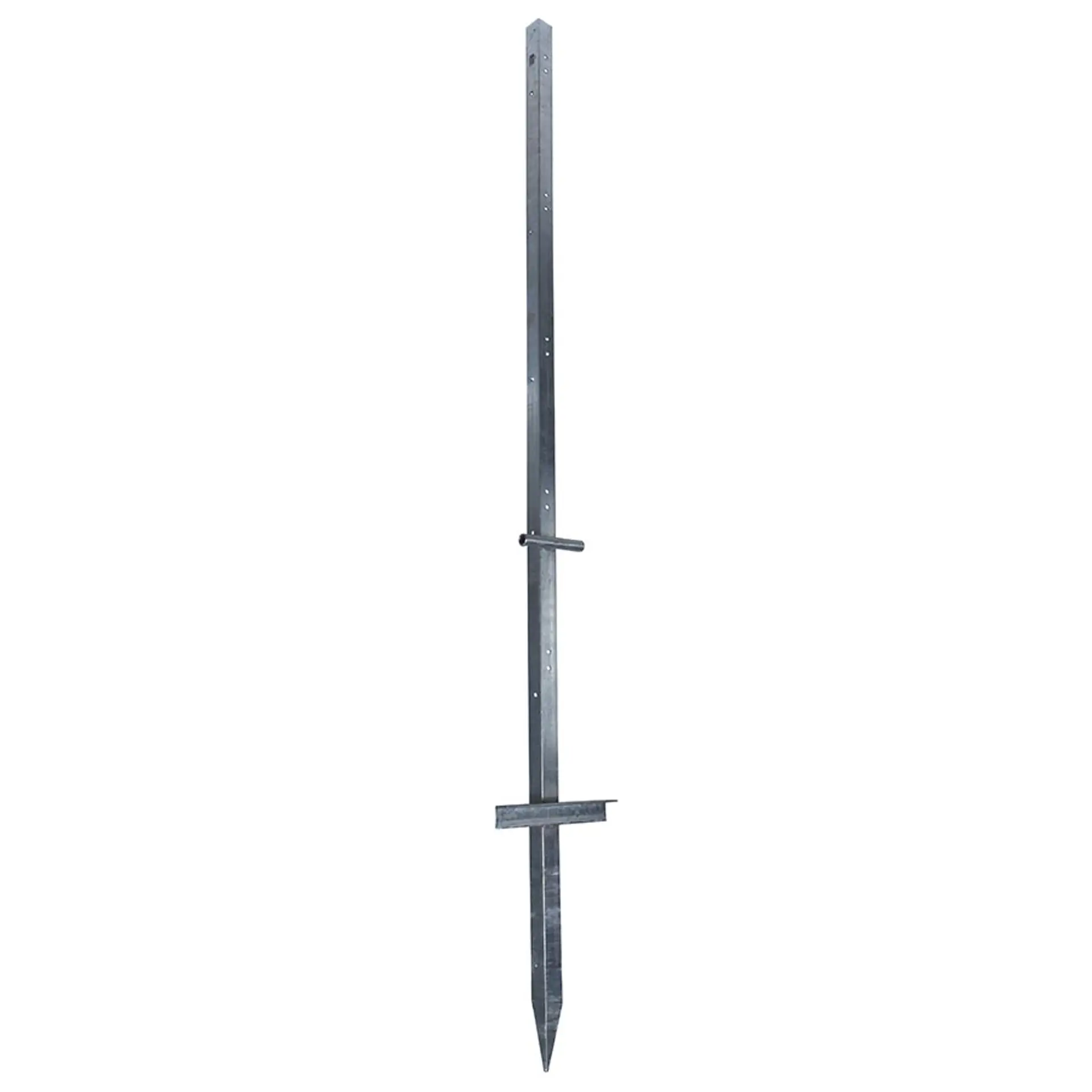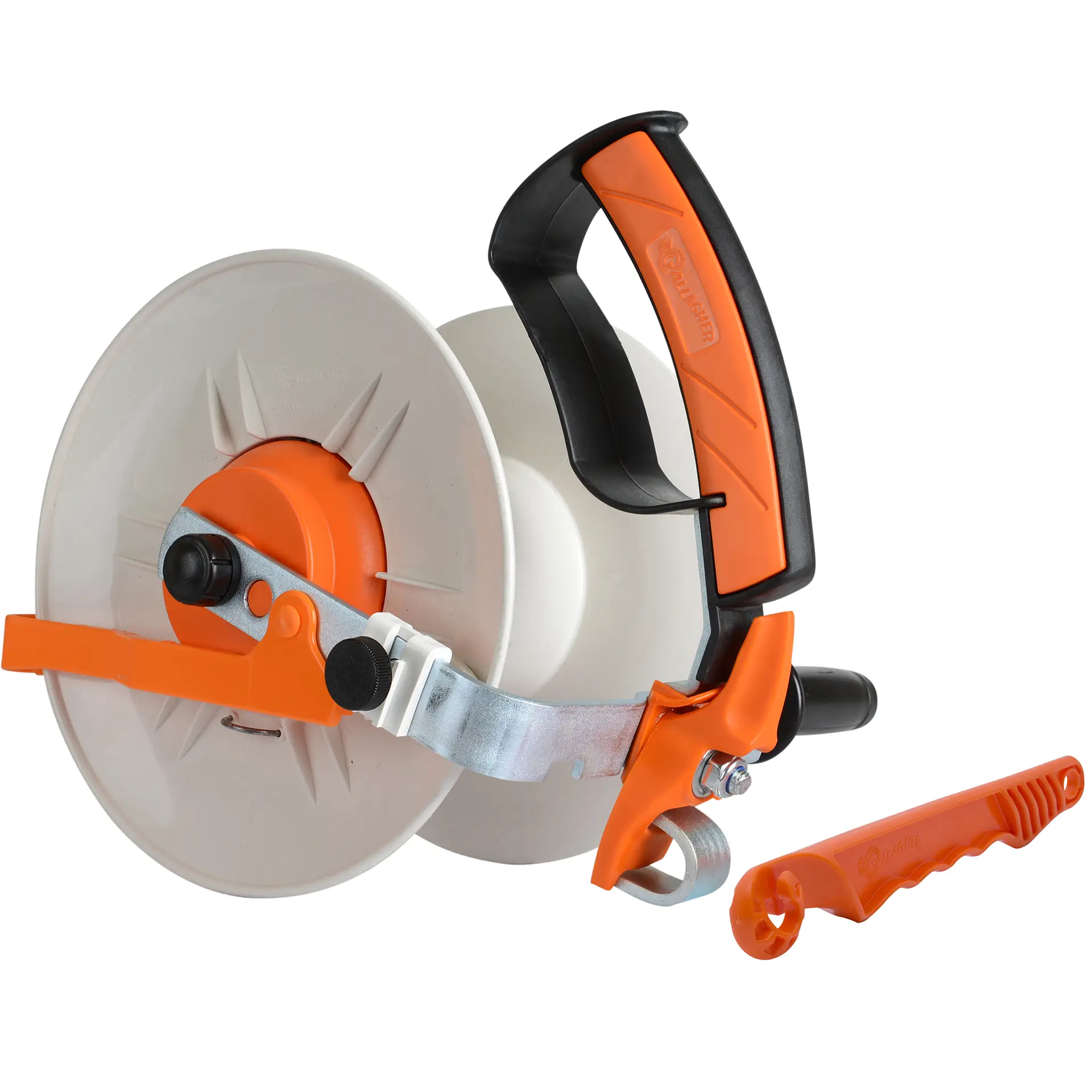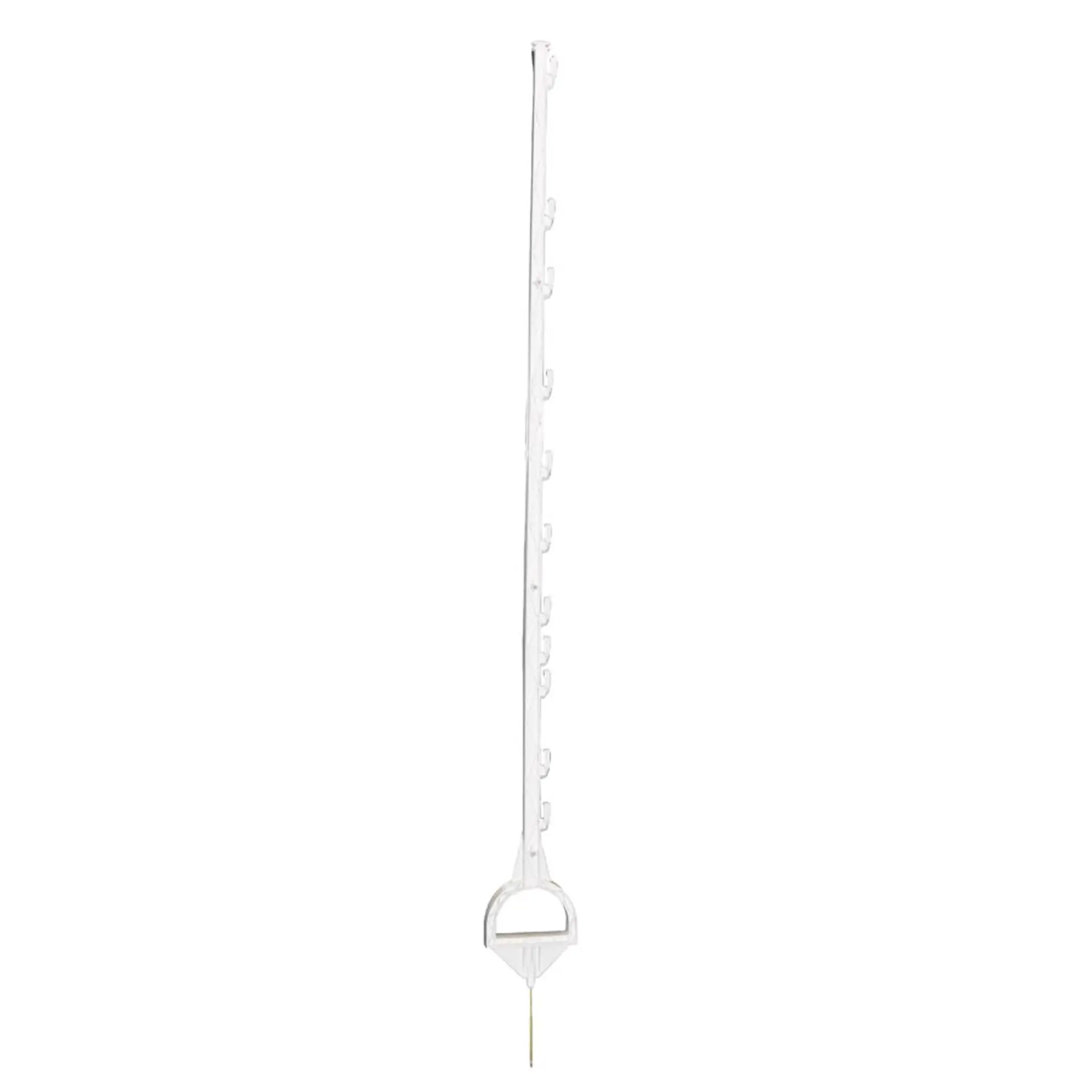
Electric fence for horses
Choosing the right horse fence is important for the safety of your horse(s). We still often see people opting for an aesthetic fence that looks nice with the house. Or that a cheap solution is chosen, to keep the horse on the pasture. All well-considered choices, but often the safety of the horse is not the main focus.
Gallagher stands for Protect what matters most. Our mission is that your horse is safe. At all times. Even if the horse goes on the run. Strange as it may sound, that is precisely when the horse should not be kept inside. It should be able to break through the fence safely and unharmed. Horses are flight animals by nature. If the horse is startled by something, it will flee and run away blind. And although a horse is highly visual, it will not shy away from any barrier at that moment. It will go right through everything. And that can have major consequences for your horse's well-being.
By choosing electric fences from Gallagher, you are choosing solutions that have been developed together with horse owners and have proven themselves in safety for years. Moreover, these electric fence solutions are three times cheaper, many times more durable and easier to maintain than conventional fences such as wood or barbed wire.
Read all about the different solutions for your horse's safety here.
Why electric fences for horses?
Permanent versus mobile fences
Paddock management with electric fence
More about permanent solution with Equifence
More about permanent solution with Tape
More about permanent solution with Rope
More about mobile solution with Tape
Which energisers are suitable for horses?
What should you pay attention to when installing horse fencing?
Horse fencing for keeping out wolves
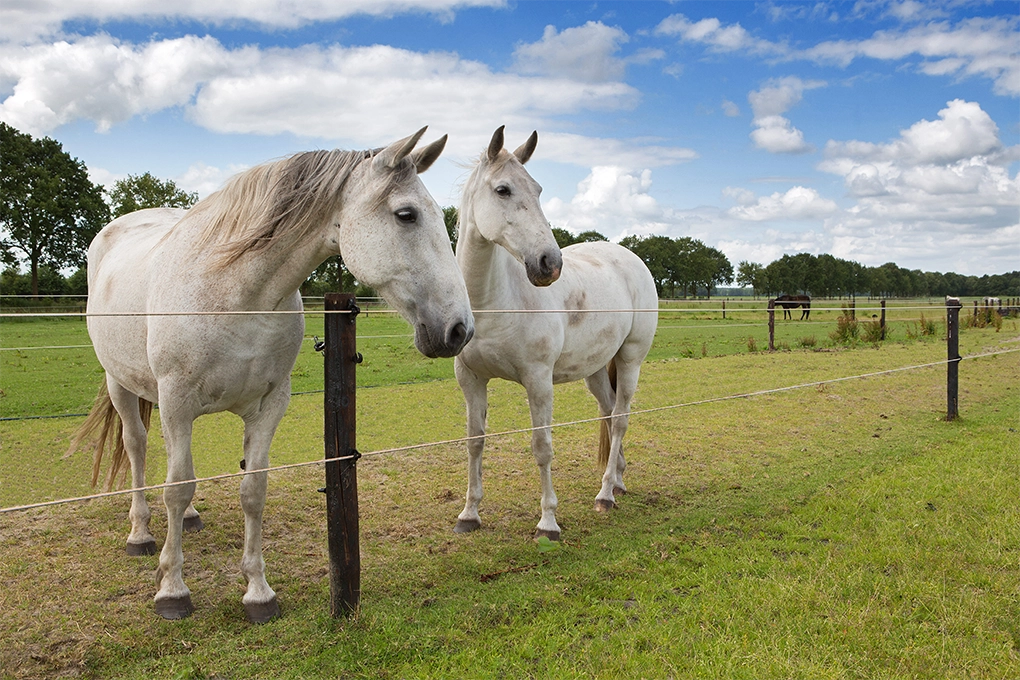
1. Safety
Every horse owner naturally wants his/her horse to be safe. Because a horse feels the pulse of the fence even at a distance, it will be discouraged from going further and will avoid the fence. Thus, you minimise escapes and prevent your horse from getting into dangerous situations. This, of course, is the basis of a fence: keeping your horse safe on the pasture. However, another important part of safety is that if your horse is startled by an external factor, it must be able to break out, without injuring itself. The horse will flee blind when startled and will then go straight through everything. To prevent your horse from getting hurt in such cases, use safe posts that bend with you, insulators and joiners without sharp edges and conductors that break when it really matters.
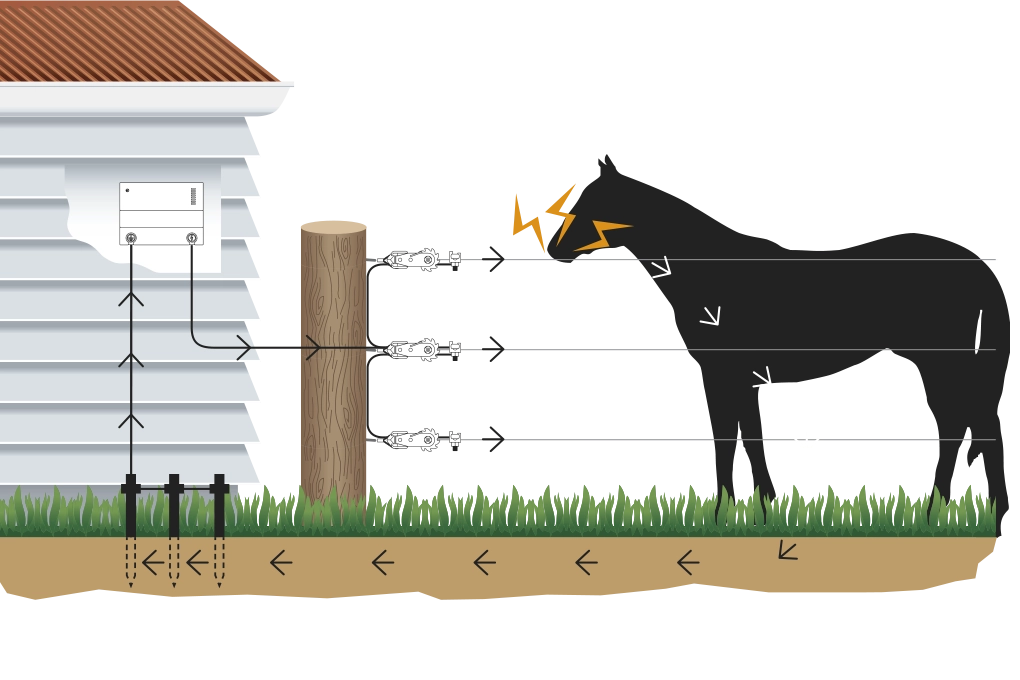
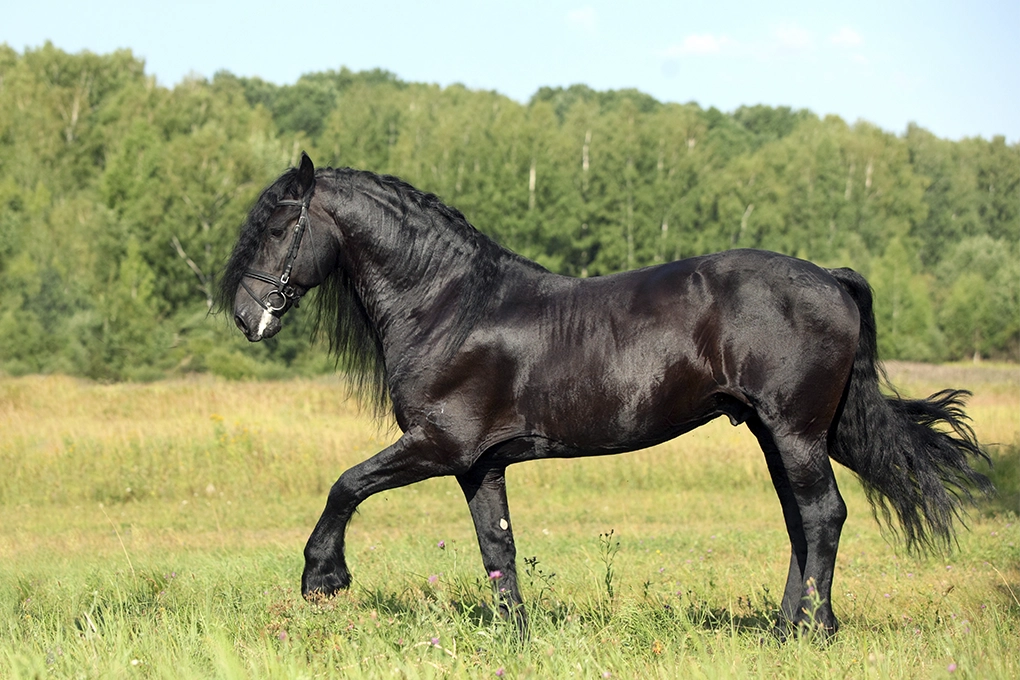
2. Cost savings
Electric fences are up to 3 times cheaper than traditional wooden or metal fences. They require less material and labour to install, significantly reducing overall costs. Moreover, electric fences are easier to repair in case of damage. Which, of course, also saves costs in the long run.
3. Flexibility
Electric fences can be adjusted and moved more easily than traditional fences. This is especially useful if the layout of the pasture changes frequently or if the horse needs to be placed in a different area temporarily. With an electric fence, horse owners can easily adapt the layout of the fence to the needs of the horse and the environment. For example, if two stallions need to be separated, electric fences can help.
4. Ease of maintenance
In general, electric fences require less maintenance than traditional fences. They do not need paint or other coatings and are less susceptible to damage from weather conditions. Checking the fence periodically with the Gallagher Check is enough to keep it functioning properly.
5. Landscape conservation
Electric fences for horses have developed considerably over the years. One of the arguments for not using electric fence was that it was landscape pollution. The white ribbons or tapes disturbed the landscape, so people preferred conventional fences, which were less disruptive to the landscape. The conductors, but also the posts and other accessories are now designed to blend into the surroundings. The colour terra has been added for conductors, gate handles, posts and other accessories to ensure that the fence blends into the landscape but is still clearly visible to the horse. Because: safety for the horse always comes first!
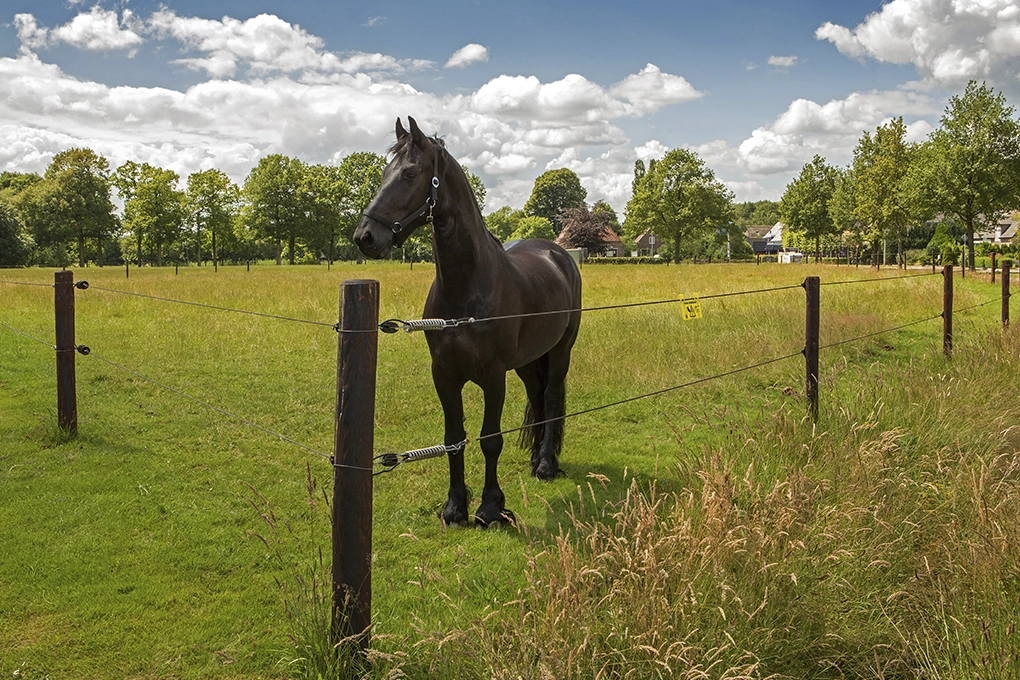
- Permanent
- Fixed installation usually by specialist.
- For permanent fences on private pastures
- Usually wooden or plastic intermediate posts and wooden corner posts. Equiwire or tape conductors.
- Hard to change or move.
- Cost effectiveness: €€€
- Maintenance: ***
- Mains device
- 9V Battery
- 12V battery
- Solar energisers
- Scalability: *
- Security level: ***
- Semi permanent
- Easy to fix yourself. Easy to remove or move yourself.
- For permanent fencing of rented pastures for longer periods.
- Gallagher Insulated line posts and wooden corner posts. Equiwire or tape as conductors.
- Relatively easy to change, move and reuse
- Cost effectiveness: €€
- Maintenance: ***
- Mains device
- 9V battery
- 12V battery
- Solar energisers
- Scalability: *
- Security level: ***
- Mobiel
- Easy to install and remove or move yourself.
- Temporary fences for temporarily borrowed meadows. Or for dividing a meadow into different pastures.
- Lightweight plastic posts. Tape or rope conductors.
- Easy to move and adjust.
- Cost effectiveness: €
- Maintenance: *
- Mains device
- 9V battery
- 12V battery
- Solar energisers
- Scalability: ***
- Security level: *
Paddock management is the careful management and maintenance of the pasture or paddock in which horses are kept. The aim of good paddock management is to create a healthy and safe environment for horses, in which adequate exercise, power supply and shelter are central.
When it comes to paddock management, electric fences are a good tool to use. This can be done with both permanent and mobile solutions. For example, with electric fence deployment, you can deploy a rotation system if you have multiple paddocks. With this, you ensure that the horses are regularly moved from one paddock to another.
This helps prevent overgrazing and maintain the quality of the grass, Also, by using electric fences, you can separate horses properly if necessary. This way, you can make sure that all horses in one paddock have high-quality grass, are healthy and can still graze outside together.
Want to know more?
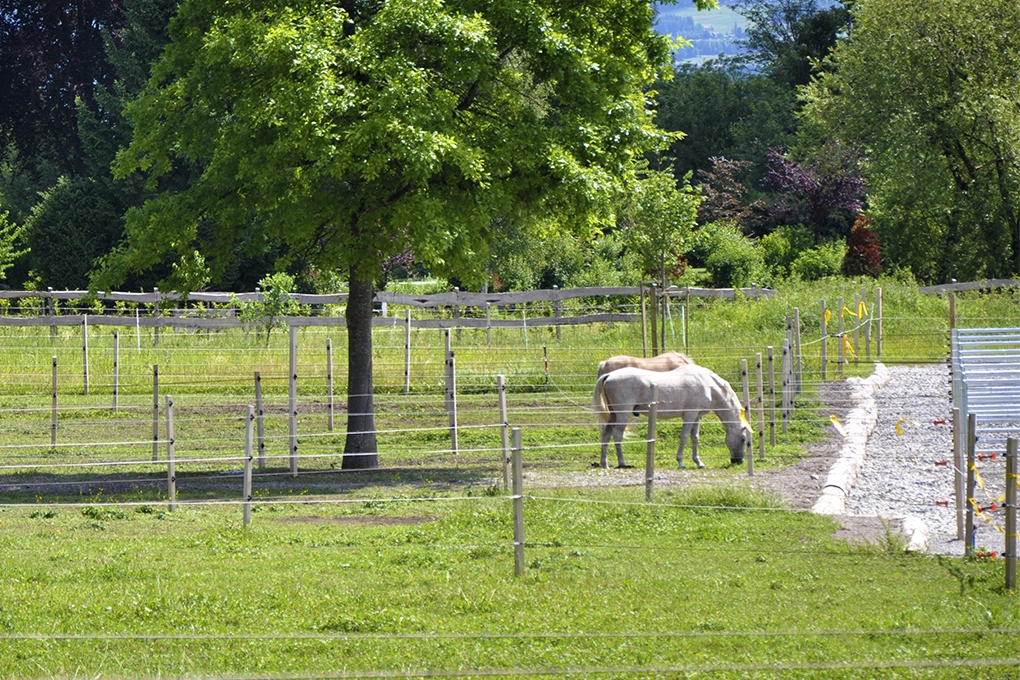
More about the permanent solution with Equifence
Equifence was developed in cooperation with European horse owners. The main premise for this conductor is safety for the horse. By now, this solution has been in use by horse owners in Europe for more than x years. And all those years of experience have resulted in this solution being constantly further developed. With its protective plastic cable, Equifence is the safest fence for horses. Equifence is the most durable fence for horses. Combined with the insulated line post and other recommended accessories and professional installation, an Equifence fence can easily last 25 years - with virtually no maintenance.... It is recommended to have Equifence installed by experts. Find an installer via this site.
The benefits of an Equifence solution at a glance:
- High visibility to help prevent animal entanglement
- Large diameter smooth coating minimises risk of injury to animal
- Polyethylene with high tear resistance and UV resistance ensures long life
- Steel core provides effective power transmission with minimum voltage drop
- Unique electrically conductive polymer ensures power is effectively maintained along the fence line
- Resistance; 35 Ohms per km Can be tightened with tensioners and tension springs (stainless steel, according to Gallagher standard). A tight fence is usually a safe fence.
- Perfect for use in combination with the Line post solution.
- Available in white and terra.
- A larger distance between posts is possible, reducing the amount of material required.
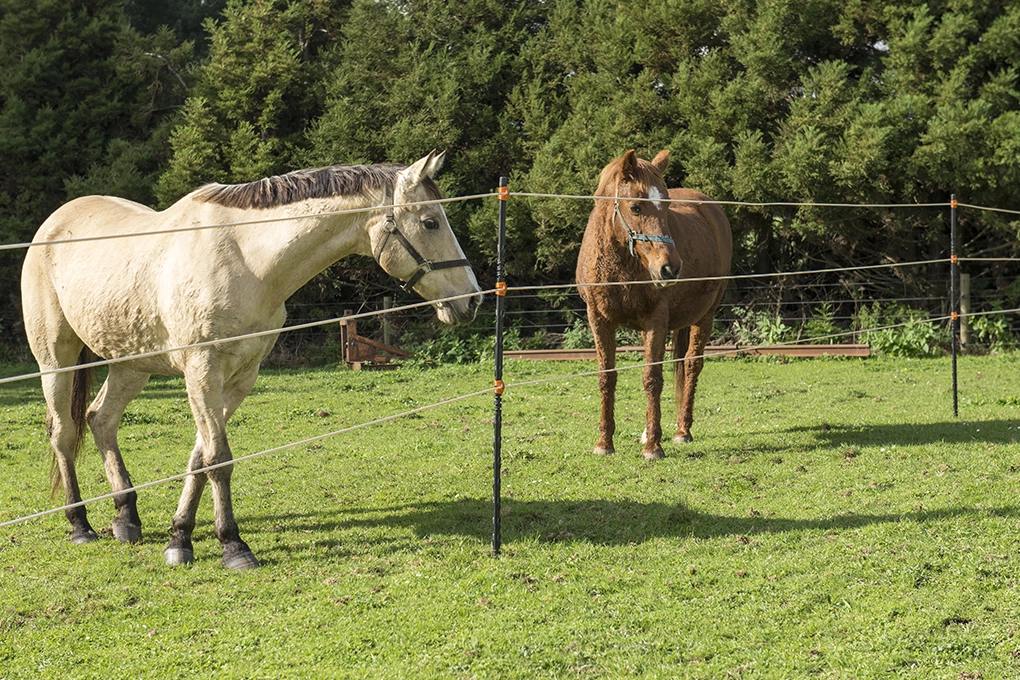
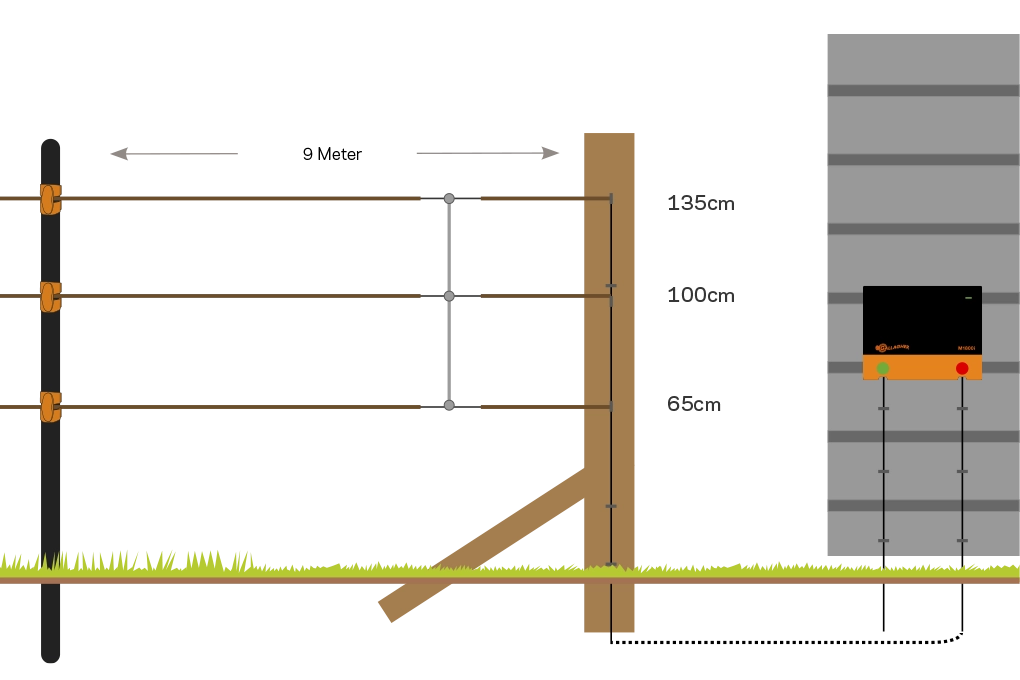
Installation advice for an Equifence solution
As installing Equifence requires some experience, we recommend having this fence installed by a Gallagher specialist. Still want to get started yourself? Then watch the installation video and apply the other tips we give you. In this way, you will create the best and safest solution for your horse(s).
Please note: The products for the Equifence solution are made to create a safe horse fence. The way in which the fence is placed ultimately determines how safe the fence is for the horse. Therefore, always adhere to the following advice: 3 rows of wires, at a minimum height of 65cm, 100cm and 135cm, with a maximum distance between posts of 9 metres.
More on permanent solution with Tape
Tape fences have been developed in cooperation with European horse owners. The main starting point for developing this conductor is safety for the horse. By now, this solution has been in use by horse owners in Europe for more than x years. And all those years of experience have resulted in the continued development of this solution.
Tape is wide (from 12.5mm to 40mm) and therefore most visible to a horse. Tape can be used in a permanent setting as well as for mobile solutions. Turbostar tape from Gallagher is the best solution. In addition to conductors in the tape, it also has a conductor at the top and bottom of the tape. As a result, the horse will not lean on top of the tape or go underneath it. Combined with the insulated line post solution and other recommended accessories, a tape fence is easy to install yourself. And can easily last for 10 years.
The benefits of a tape solution at a glance:
- High visibility to help prevent animal entanglement
- Lightweight, high conductivity, reliable and hard-wearing tape ideal for both permanent and mobile fencing
- Can be tightened with tensioners. A tight fence is usually a safe fence
- Perfect for use in combination with the Line post solution.
- Available in white and terra; in view of landscape pollution, we recommend the terra variant.
- In case of impact due to escape behaviour, the tape will break with minimal risk of injury to the horse.
- UV-resistant material (UV guarantee of x years)
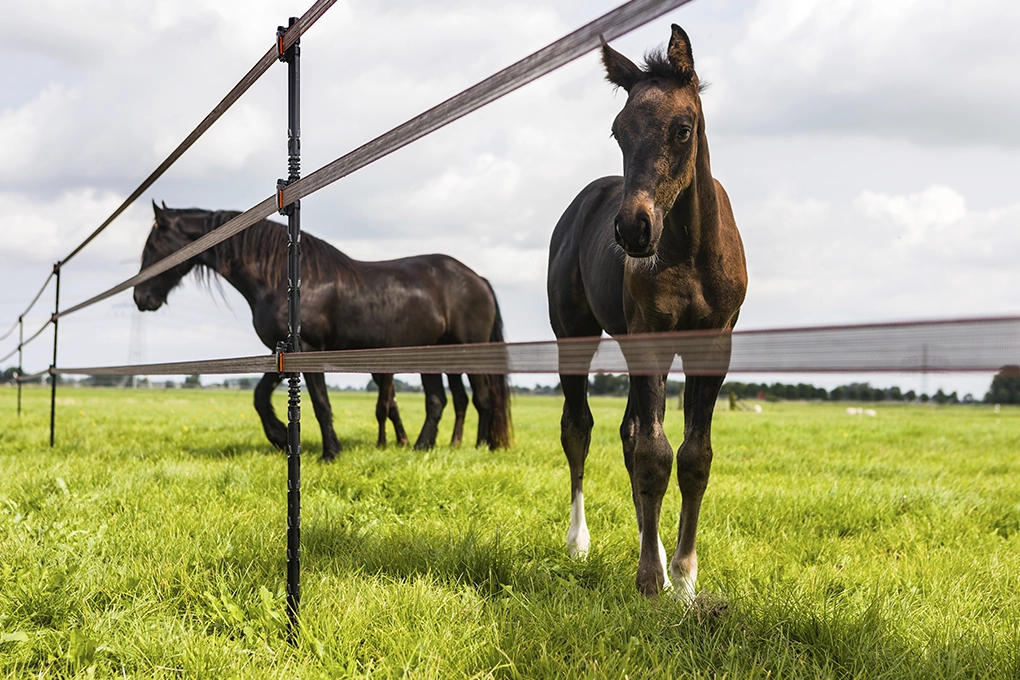
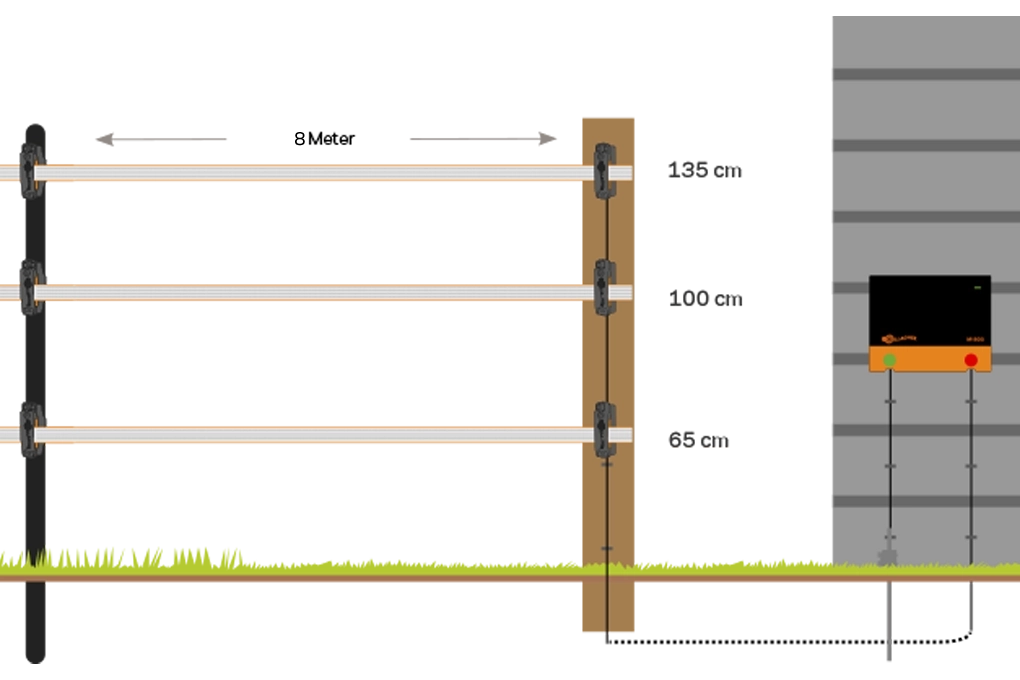
Installation advice for a permanent tape solution
A permanent fence combined with the insulated line posts solution, is easily installed by any horse owner himself. Watch the installation video and apply other advice given by us. This way you will create the best and safest solution for your horse(s).
Please note: The products for the tape solution are made for creating a safe electric fence. The way the fence is placed ultimately determines how safe the fence is for the horse. Therefore, always adhere to the following advice for a horse fence: 3 rows of tape, at a minimum height of 65cm, 100cm and 135cm, with a maximum distance between posts of 8 metres.
More on permanent solution with rope
Electric fences for rope are usually widely used by horse owners. This is because it is the most cost-efficient solution. Rope is a great horse fencing solution, but does require more maintenance and excellent installation to make it safe for the horses. If you are looking for a more secure fence for horses, we recommend choosing tape or Equifence. Combined with the Linepost solution and other recommended accessories, an insulated line post fence is easy to install yourself. And can easily last for 5 years.
The advantages of rope fences at a glance
- Wear-resistant fence with 7-year UV guarantee!
- Woven structure that prevents stretching.
- Ideal for fences longer than 500 metres.
- Easy to install yourself.
- Relatively low investment
- 10-year guarantee when used with recommended Insultimber, Insulated Line Posts or Eco Posts
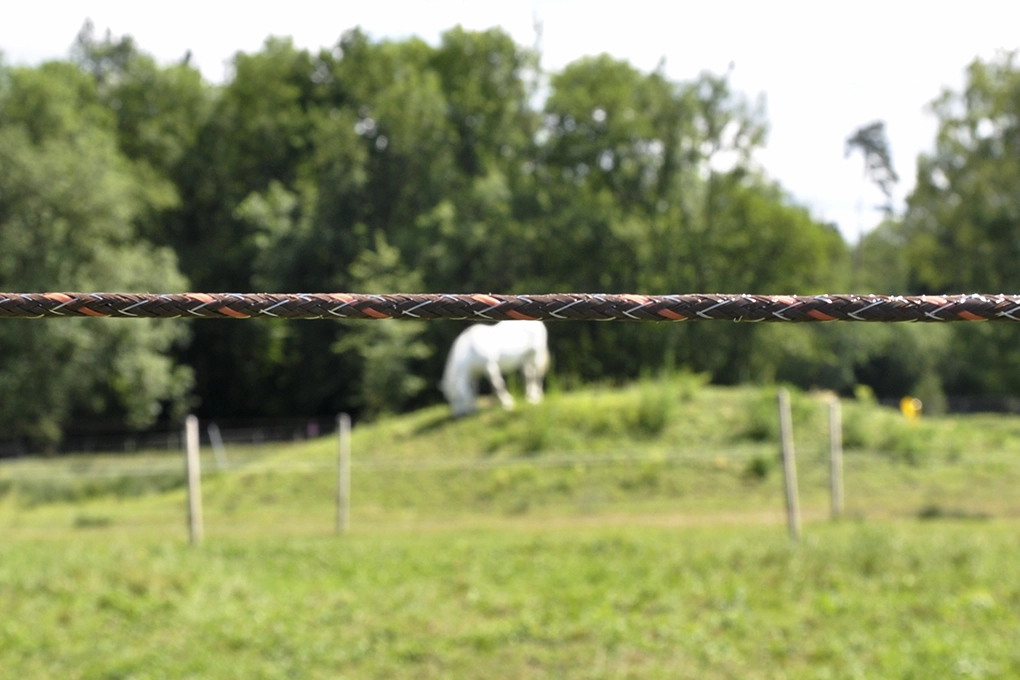
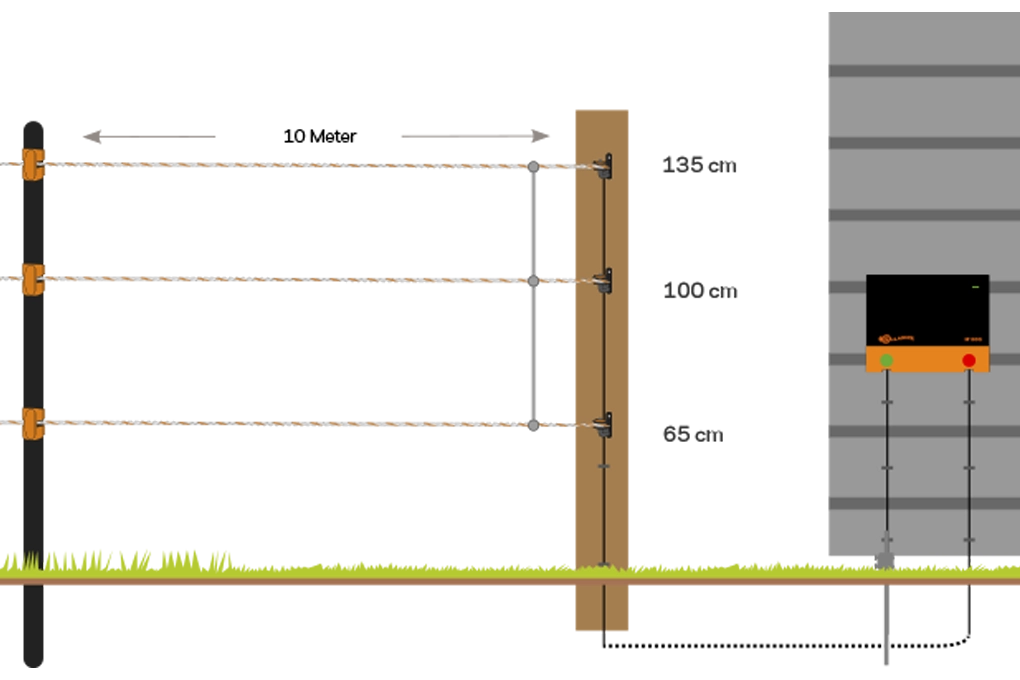
Installation advice for a permanent rope solution
A permanent fence in combination with the insulated line post solution, is easily installed by any horse owner himself. Watch the installation video and apply other advice given by us
Note: The way the rope fence is installed ultimately determines how safe the fence is for your horse. Therefore, always adhere to the following advice for a horse fence: 3 rows of rope, at a minimum height of 65cm, 100cm and 135cm, with a maximum distance between posts of 10 metres.
More on mobile solution with Tape
A mobile fence with tape is ideal for creating temporary, easy-to-move paddocks. It is also perfect for subdividing large fields. Like the permanent fences, these mobile ribbon fences were developed in cooperation with European horse owners. The main starting point for developing this conductor is safety for the horse and mobility for the horse owner.
Tape is wide (from 12.5mm to 40mm) and therefore best visible to a horse. A mobile fence consists of plastic posts, a conductor and reels. Gallagher's plastic posts feature the unique Twist & Lock system. This means that the line can be set up in one go, and is then firmly fixed.
The benefits of a tape solution at a glance:
- High visibility to help prevent animal entanglement
- Lightweight, highly conductivity, reliable and hard-wearing tape ideal for both permanent and mobile fencing
- Can be tightened with tensioners. A tight fence is usually a safe fence
- Perfect for use in combination with the twist and lock horse post.
- Available in white and terra; in view of landscape pollution, we recommend the terra variant.
- In case of impact by flight behaviour, the tape will break and/or the mobile horse posts will bend with it, with minimal risk of injury to the horse.
- UV-resistant material (UV guarantee of x years)
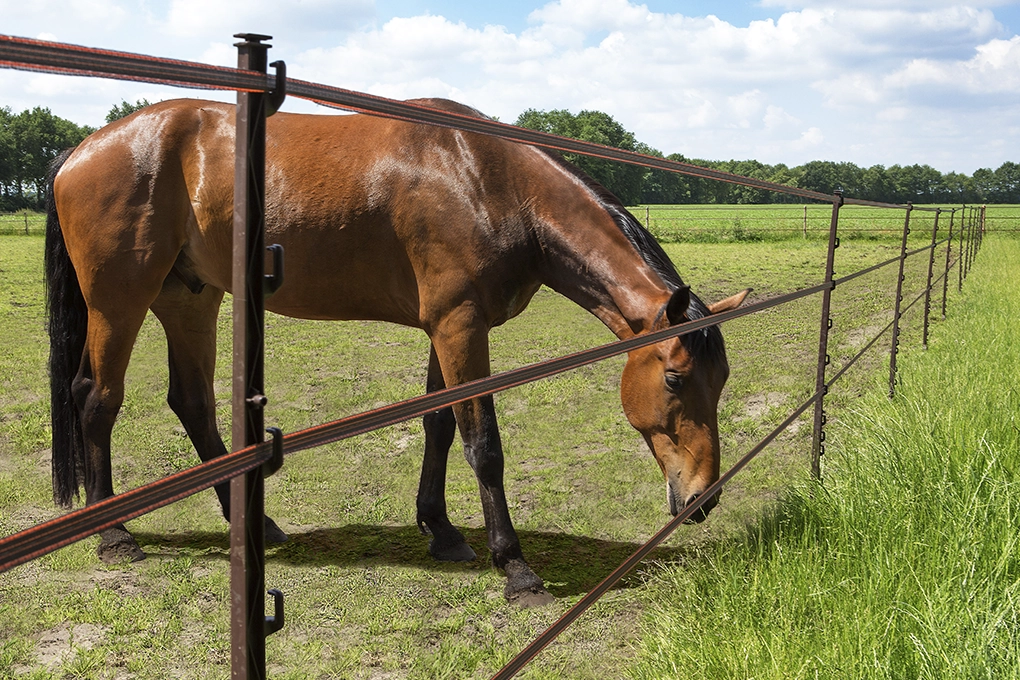
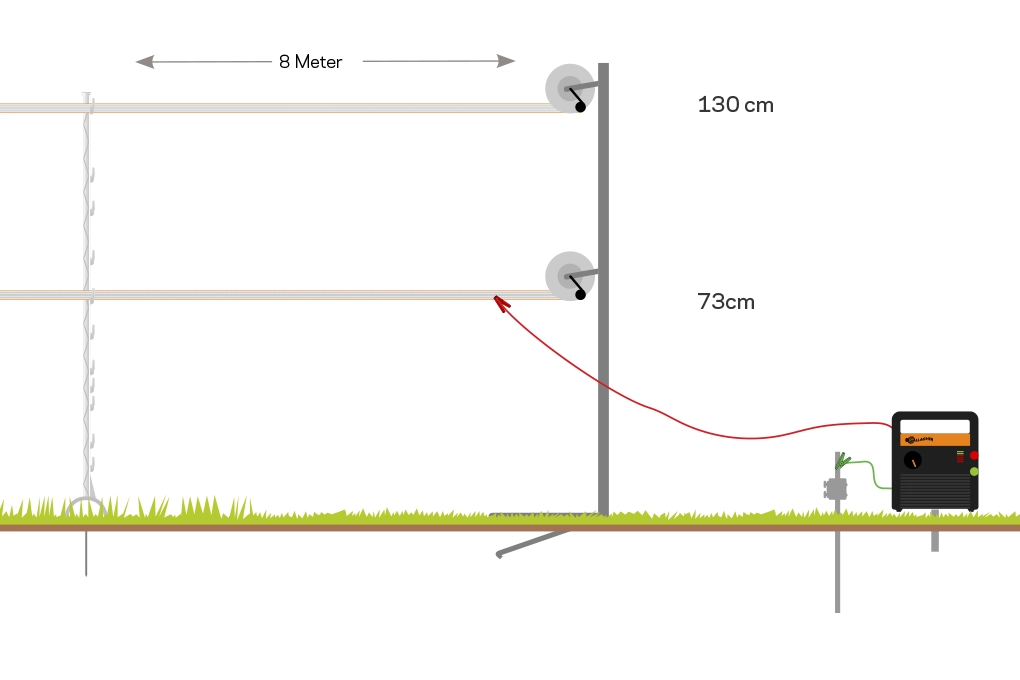
Installation advice for a mobile tape solution
Gallagher recommends the horse post with wire holders for horses and ponies. For mobile fences for horses and foals, we recommend 12.5mm Turbo tape. Ideally, reels are used for the convenience of the horse owner so that the conductor can be reused. For mobile fences, reels are attached to a reel corner post.
Note: The products for the mobile tape solution are made for creating a safe mobile electric fence. How the fence is placed ultimately determines how safe the fence is for the horse. Therefore, always adhere to the following advice for a mobile horse fence: 2 rows of tape, at a minimum height of 73cm and 130cm with a maximum distance between posts of 8 metres.
Which energiser is suitable for horses?
The answer is actually quite simple: all energisers are suitable for horses. A horse fence is powered depending on which source is available. If there is mains power near the fence, our advice is to always use this. If this is not available, you can choose an energiser with an integrated solar panel or a battery or battery device. When choosing an energiser, it is important to take into account the length of the fence, the amount of vegetation in the field and how many wires the fence has. With the Gallagher configurator, you can draw in your pasture and find out which fence suits you best.
Did you know that with our iSeries energisers, you can easily check the safety status of your paddocks on your smartphone?
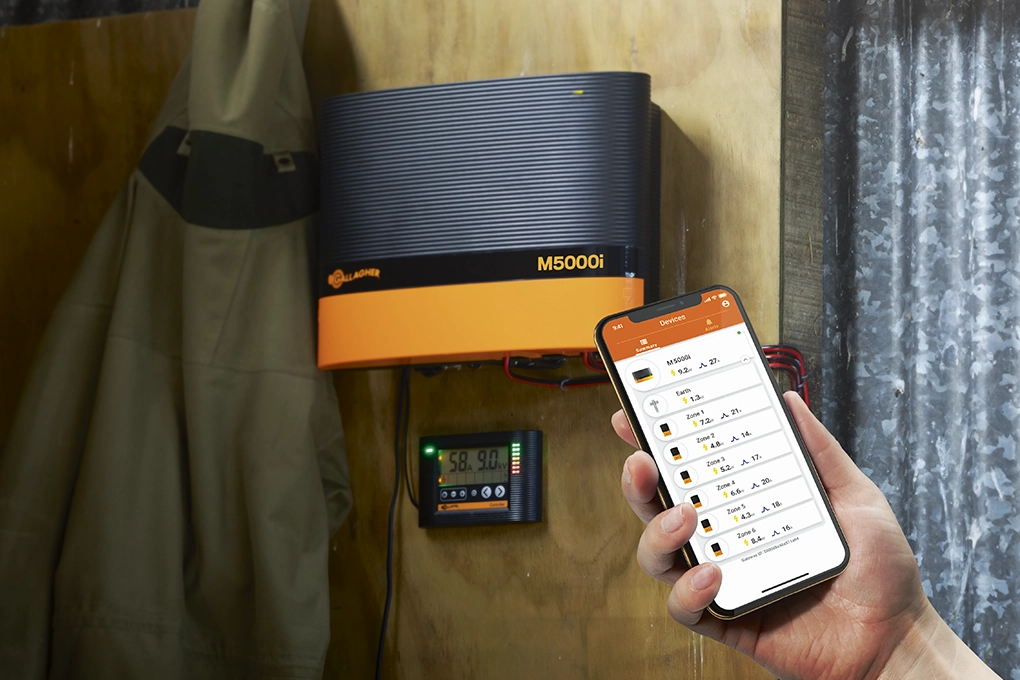
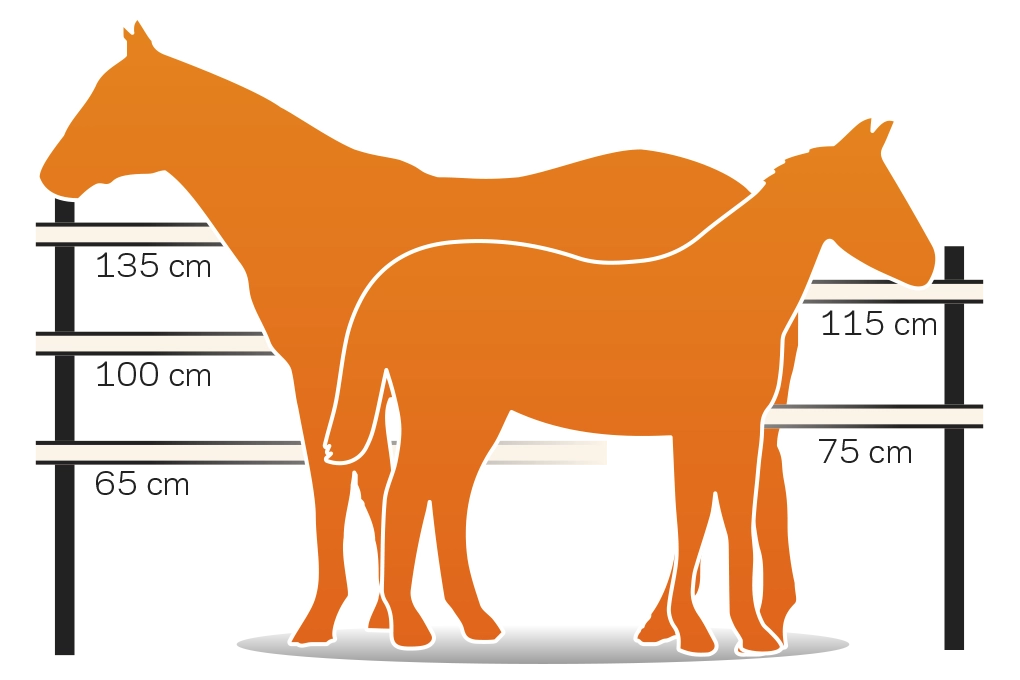
What to look out for when installing fences for horses
When installing fences for horses, there are 4 important points to consider:
1. The height of the fence: Horses are naturally good jumpers, and a fence that is too low will make them jump over it easily.
2. The height of the lowest wire: Horses like to roll on the ground which means they can end up with their legs in the wire (if there is no current on it). Therefore, always keep the minimum height of 65cm for the lowest wire.
3. The distance between the different wires: This is important so that the horse has no room to manoeuvre between conductors.
4. The distance between fence posts: If the distance between posts is too long, the wires will sag too much, reducing safety. The horse may become entangled in these or be unable to break through them if they break out.
The rule of thumb for mobile fences is 3-4 metres, for permanent fences it is 7 to 9 metres.
Horse fencing for keeping out wolves
Increasingly, we receive questions about keeping wolves away from foals, ponies and horses. This is a very delicate question. A question we unfortunately cannot give one generic answer to. Every situation is different, which is why we are happy to discuss this with you.
Leave your details and we will contact you to discuss the various solutions.
